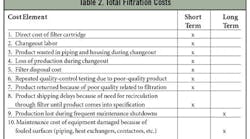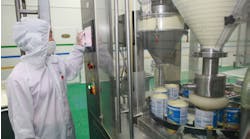Filtration is rarely the first concern when developing a new or improved process. Far more attention is given to product yield, minimizing unwanted byproducts, avoiding environmental problems and achieving favorable process economics. Although filtration rarely is considered early, it often significantly affects process economics -- both through the direct cost of filtration and through its impact on the acceptability of filtered fluid (filtrate) for the next process stage or final application. This article discusses key parameters for cartridge filter systems, to show how design choices affect costs and to identify various cost elements impacted by cartridge filter choice.
Filters are used to protect the process and the product. For instance, at refineries and natural gas processing facilities that use alkanolamines in gas-sweetening systems, removing contaminants from the recirculating amine stream can be important in minimizing operating problems, such as from foaming within gas/liquid contactors. Particles are known to stabilize foaming [1] that can reduce gas contactor throughput. Another example is the benefit that carbon columns receive from particulate filtration. So-called "mechanical" filters upstream of the columns protect the activated carbon granules from being plugged with debris that would impede fluid access to the activated carbon surface. Downstream, another set of particulate filters protects the fluid system from the fines generated by mechanical abrasion of granules within the carbon bed. Filters keep debris from continuing downstream to successive stages. When such carryover occurs, critical equipment, such as heat exchangers, may become fouled or the final product may be forced out of specification.
Filtration fundamentals
Several basic factors play key roles in selecting the right cartridge filtration system, including:
The nature of the contaminant.
The contaminant is extremely important in determining how readily filtration can be accomplished. Rigid, angular particles are easy to remove from a fluid. Flexible contaminants, including fibers, aren't always easily removed because they sometimes can "snake" their way through the filter structure. The most difficult to remove are deformable gels. These have the ability to blind a filter by smearing over its surface. At high pressure drop, gels also can be extruded through the filter structure. They then emerge as a coalesced mass, possibly larger than pores within the filter, on its downstream side. Gels are best handled by reducing flux through the filter and operating at the lowest possible pressure drop across it. The use of filtration media with a graded porosity often is very effective in removing gels. Such media have progressively smaller pores going from upstream to downstream within the filter.
Types of filtration media.
The work of separating contaminants from a fluid is done by filtration media. They can be grouped into three basic categories: surface, depth and adsorptive. Surface filters act like sieves. Particles too large to pass through the holes (pores) are retained on the surface. As contaminant cake builds on the surface, the degree of filtration often grows finer. A surface filter medium is generally thin. It commonly is pleated to maximize surface area packed into the filter cartridge, thereby increasing the amount of dirt that can be retained. In contrast, depth filters rely on a much thicker medium. Dirt particles must follow a tortuous path to pass through the filter cartridge. This complex path increases opportunities for particle capture within the filter matrix. The depth of such media leads to higher pressure drop across them than across a surface medium of comparable pore size.
Adsorptive filter media are capable of retaining particles smaller than the rated filter pore size. This is possible in some systems because of surface charge modification of the filter media. The charge is most effective over short distances from the surface and falls off exponentially as distance increases. Accordingly, such filter structures are principally employed in sub-micron filtration.
The structure of the filter medium plays an important role in capturing and retaining contaminants. Filter media can be broadly categorized as non-rigid or rigid. Contaminants trapped within non-rigid structures are more likely to be released back into the fluid stream because such structures can deform. This effect is especially pronounced in the case of pulsating pressure associated with diaphragm pumps. Non-rigid filters, such as yarns wound around a core, often find use because of their wide availability and generally low purchase price. Rigid filter structures are better able to resist deformations and, thus, lessen the likelihood of releasing contaminants back into the fluid. Fluid bypass is also less likely with rigid filter cartridges because they don't collapse under increasing differential pressure across them, which could pose the danger of compromising the seal at the ends of the cartridge.
Flow rate.
The rate at which fluid passes through a filter strongly influences its performance. A common experience is that doubling the number of filters used on a process stream results in more than twice the amount of fluid that can be processed before a filter change is needed. This nonlinear relationship has been expressed as [2]:
L
2 = L1 [Q1/Q2]n (1)
where L1, L2 = filter life at conditions 1 and 2;
Q1, Q2 = flow rate through the filter at conditions 1 and 2; and
n = a filter life factor that can have values between 1 and 2.
For illustration, if Q1 is the flow rate at which a given filter currently operates and equals 10 gpm, and L1, the life of the given filter at that flow rate, equals 8 days, then at new flow rate Q2 of 5 gpm, the expected life L2 of the same filter for an n of 1.3, which is a reasonable value for real-life systems, is calculated from Eq. 1 to be:
L2 = (8)(10/5)(1.3) = 19.7 days
This is about 2.5 times the life at the 10 gpm flow rate. The same result would be reached if the original number of filters in parallel were doubled, while maintaining the original process flow rate of 10 gpm, thus halving the flux through individual filters.
Operating range.
Disposable cartridge depth filters are convenient to use but, at some point, they must be changed. As the fluid contaminant load increases, the frequency of changeouts necessarily rises. For very dirty fluids, the volume available in a filter housing for deposited solids can become a limiting factor. A practical rule of thumb is that cartridge filtration is best suited for conditions where the fluid contaminant level is lower than about 1,000 mg/L (or ppm), which equals 0.1 wt.% suspended solids.
Filter performance. Two parameters are critical. One is filtration efficiency or degree of filtration, and the other is filter life. A filter that is too tight will deliver good quality filtrate but will have an uneconomically short life. In contrast, a filter with pores too open will have long life but the filtrate will be poor quality and cause problems for the downstream customer -- either the next processing stage within the plant or the final customer outside the plant. Both affect process economics and the true total filtration cost.
Important considerations
Let's look at key factors in choosing and installing a cartridge filter.
Filter ratings.
Degree of filtration reflects the cleanliness of the filtrate. It has to do with the size and number of particles in the filtrate. Comparing these values with the size and number of particles in the feed also indicates how efficient the filter is in removing particles larger than a specific size. The micron rating of a filter is related to the degree of filtration. Typically, filters are given nominal or absolute ratings. Both ratings assign small numbers to tight filters and large numbers to open filters. Nominal ratings also may be used for filters whose basic structures or manufacturing processes are not amenable to stricter characterization. For example, some filters are made by winding a synthetic yarn around a core. Typically, the yarn has a smooth, slippery surface. While in service, increasing differential pressure across these filters makes the yarn shift position and change the apparent pore size. A filter with changing pore size cannot be assigned an absolute rating.
Absolute ratings come closer to representing the true size cutoff of particles that can be kept from passing downstream. A typical absolute rating system cites the Beta Ratio or Beta Value of a filter. The Beta Ratio [3] is:
x= (cumulative number of particles in feed larger than x)/
(cumulative number of particles in filtrate larger than x) (2)
Equation 3 defines the relationship between Beta Ratio and particle removal efficiency (PRE) expressed as %:
PRE
= [( - 1) / ] x 100 (3)
Table 1 details how various Beta Values relate to PREs. The steepest increase in particle removal efficiency occurs at low Beta Values, while at high Beta Values particle removal efficiency changes relatively little.
Filter ratings depend upon the test protocol employed. Important variables include: choice of fluid and contaminant, flow rate, temperature, method of introducing contaminants to the fluid, piping system configuration and method of counting particles. ASTM F795 [4] is a commonly used basis for such testing. Practical considerations lead individual filter manufacturers to modify this procedure in various ways. Because of such differences in test methods, it is not possible to accurately compare the filter ratings from different manufacturers. Neither nominal nor absolute ratings can predict exactly what will happen in a specific practical filtration system. However, filter ratings are useful as guidelines in seeking the right filter for a particular job. Generally, absolute ratings more closely approximate actual performance.
Surface versus depth filters.
For a given pore-size rating, pleated surface filters deliver higher initial flow rates than depth filters. This can be attractive because of the potential for minimizing the housing size. However, many other factors affect filter performance in a real system. Chief among these is the nature of the contaminant. Deformable gelatinous contaminants are often best removed by depth filters operated at low fluid flux. Pleated filters can be effective for fluids with high total suspended solids. However, if there is too little space between the pleats for the application, the filter will blind off and form a circumferential cake at the outside diameter of the filter cartridge. This cake prevents dirty fluid from entering between the pleats and the fluid is unable to access the large pleated surface area. Depth filters, especially those with gradient pore size from outside to inside, combat this problem by trapping larger contaminants in the upstream part of the filter and smaller contaminants deeper within the cartridge. This maximizes the filter's contaminant load capacity. In real systems, the contaminant type, size distribution and load (mg/L), coupled with the fluid viscosity, etc., will determine whether surface or depth filters should be used.
Compatibility.
The filter cartridge and the fluid must be compatible. Variables affecting compatibility include service temperature, duration of exposure and concentration of any component capable of causing filter degradation. No table of compatibilities can be complete enough to cover all fluids or conditions of exposure. Experience in identical or similar systems can be highly valuable. Without such information, some sort of testing is required. "Bucket testing" -- in which a cartridge is put into a pail of the process fluid for a relevant amount of time -- can be useful. It suffers from difficulties in running the test with hazardous fluids, at elevated temperature, from change in fluid composition with time and from being a static rather than a flow-through test. If the filter cartridge seems somewhat affected but not destroyed, further testing is essential to see if it can provide adequate service life or if a more chemically resistant filter is necessary.
An identical cartridge should be tested to measure the extent of the attack. However, an appropriate compatibility test, which might involve a filter's compressive or tensile strength, may not be easy to develop. Despite the potential problems in devising it, such a test is worth pursuing, especially in systems for which there is little prior experience. Some filter housings have enough room internally to permit placing an extra filter cartridge somewhere in the housing, enabling exposure to actual process conditions. It is also possible to install a dummy test filter in one position within a housing. In such cases, the position should be blanked off, with no flow through the filter, to prevent downstream contamination should the test cartridge fail.
Filter housings.
These contain the cartridges and come in a variety of sizes and shapes. The number of "equivalent length" filter cartridges needed to accomplish a given task depends upon the required degree of filtration, contaminant characteristics and the viscosity, temperature and flow rate of the fluid. For a given micron rating, three 10-in. cartridges have the equivalent filtration capacity of a single 30-in. cartridge. Once the number of equivalent length filters has been determined, the housing can be specified. For a given number of equivalent lengths, it generally is more economical to choose a small-diameter tall filter housing rather than a large-diameter short housing. Another choice is whether to orient the housing vertically or horizontally. Operators changing cartridges generally find that horizontal housings facilitate cartridge removal and installation, especially if there are many cartridges and they are 40 in. or more in length. In all cases, available space plays a key role in determining housing dimensions and orientation.
Filter location.
Proper placement can assist filters in doing an effective job. Contaminants should be removed as close to the beginning of the process as possible. For instance, in a polymerization or a multi-ingredient paint-making process, it is far easier to remove dirt from solvents by treating the solvent alone than it would be to remove the same dirt after all components, including high viscosity resins, are present. The added benefits of filtering as close to the source as possible can include being able to treat smaller volume streams and the prospect that filtration may be easier in terms of temperature and absence of chemically aggressive materials.
Filters should be located within the process at the lowest temperature possible because this usually offers benefits in solids solubility and minimizes compatibility issues between the filter structure and the process fluid. The location should also provide adequate workspace needed for changing filter elements and should enable easy sampling of the fluid upstream and downstream of the filter to monitor its performance.
Full versus partial filtration.
Recirculating process streams can be filtered partially, usually via 10-20% side streams, or fully. Filtering only a side stream reduces the initial capital cost of the system. Unwanted solids in the recirculating fluid, however, are not effectively removed without full-flow filtration. In many systems, particularly refineries processing very sour crude oil and gas plants handling very sour gas, serious problems, including heat exchanger fouling, foaming, corrosion and fouling of the trays in the contactors and strippers, have arisen because contaminants from the circulated fluid became deposited in critical places. Upsets in the system can result in frequent shutdowns and loss of revenue. Stable operation is promoted by removing suspended solids as quickly as possible -- which calls for filtration of the full process stream.
Capital versus operating costs.
The installed cost of the filtration system must be balanced against operating cost. Budget restraints sometimes lead to installation of under-designed systems that bring unusually high operating costs. Filters in these systems will have short life because of high fluxes through them. They also may not effectively capture certain contaminants such as gels because of the excessive fluxes.
Filter versus filtration cost
The expense of a filter is only part of the overall operating cost for filtration [5]. Table 2 lists typical expenses, including the cost of the filter, plus a number of other important items.
Items 1 through 8 in the table cover a variety of filtration costs that are incurred short term, around the time the filters are placed in service. These are relatively easy to identify among a plant's operating expenses. Items 9 and 10 are costs that only become evident after a longer term, often many months later. They can markedly exceed the short-term costs but are not as easily identified among total plant expenses. The important point is that direct filter cost is only a part of total filtration cost.
Consider the case summarized in Table 3, which compares low-cost filter A to a more expensive but better-performing filter B. The table shows typical parameters describing the total filtration cost for each case. Filter B clearly offers significant cost savings even without taking Items 6-10 from Table 2 into account. These items are too case-specific to include in this example; their effect, however, would be to increase the savings realized by using the "more expensive" filter.
Summary
The key to effective and economic filtration is properly matching the filter to process conditions. Important considerations are the nature of the contaminant, choice of filter media type, compatibility between filter and fluid, flow rate through the filter, location of the filter within the process and partial versus full flow filtration. The simple cost of a replacement filter represents only part of filtration expenses. Controlling the total cost of filtration can lead to significant savings in overall process costs.
Ronald V. Repetti is a senior applications specialist and Alan R. Ponchick is a senior sales specialist for CUNO Inc., Meriden, Conn.


